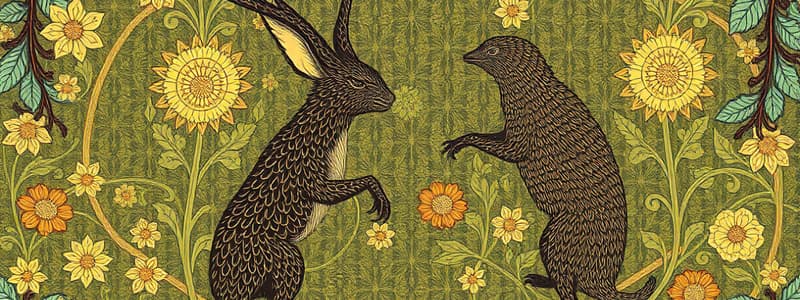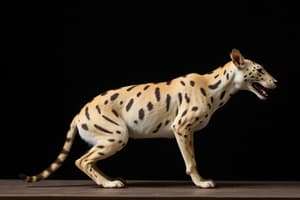Podcast
Questions and Answers
What is the connection between Clever Hans and Lloyd Morgan's Canon?
What is the connection between Clever Hans and Lloyd Morgan's Canon?
Lloyd Morgan's Canon, which promotes seeking the simplest explanation, highlights the issue with the methods used to study Clever Hans. The horse was initially believed to solve math problems, but it was later discovered that he was responding to unconscious human cues, not actual reasoning.
What are Tinbergen's four questions for understanding animal behavior?
What are Tinbergen's four questions for understanding animal behavior?
Tinbergen's four questions are Causation (Mechanism), Development (Ontogeny), Function (Adaptation), and Evolution (Phylogeny).
What is the main idea behind Lloyd Morgan's Canon?
What is the main idea behind Lloyd Morgan's Canon?
Lloyd Morgan's Canon advises adopting the simplest explanation for animal behavior, avoiding assumptions of higher reasoning unless supported by strong evidence.
According to Tinbergen's four questions, what aspect of cat play behavior is addressed by the question, "What is the evolutionary history of play behavior in cats?"
According to Tinbergen's four questions, what aspect of cat play behavior is addressed by the question, "What is the evolutionary history of play behavior in cats?"
Who are the three fathers of ethology?
Who are the three fathers of ethology?
What did Niko Tinbergen introduce to the study of animal behavior?
What did Niko Tinbergen introduce to the study of animal behavior?
Which of the following is NOT a key characteristic of a Fixed Action Pattern (FAP)?
Which of the following is NOT a key characteristic of a Fixed Action Pattern (FAP)?
What is the comparative method in animal behavior research?
What is the comparative method in animal behavior research?
What is the main argument of Euan MacPhail's Null Hypothesis?
What is the main argument of Euan MacPhail's Null Hypothesis?
What is the difference between homology and analogy in the evolution of cognitive abilities?
What is the difference between homology and analogy in the evolution of cognitive abilities?
What is umwelt?
What is umwelt?
How is animal perception studied?
How is animal perception studied?
What is imprinting?
What is imprinting?
What is the key difference between primary and secondary imprinting?
What is the key difference between primary and secondary imprinting?
Imprinting is more likely to be successful in precocial birds than altricial birds.
Imprinting is more likely to be successful in precocial birds than altricial birds.
What is the Ebbinghaus illusion?
What is the Ebbinghaus illusion?
Research suggests that the Ebbinghaus illusion is purely a cultural phenomenon.
Research suggests that the Ebbinghaus illusion is purely a cultural phenomenon.
Flashcards
Lloyd Morgan's Canon
Lloyd Morgan's Canon
An approach to studying animal behavior that avoids assuming complex mental processes and favors simpler explanations like instinct, conditioning, or trial and error.
Clever Hans
Clever Hans
A phenomenon where an animal appears to be intelligent but is actually responding to unconscious cues from its observer. This is often used as an example to illustrate why Lloyd Morgan's Canon is important.
Tinbergen's 4 Questions
Tinbergen's 4 Questions
The four questions that should be asked to understand any given behavior: Causation (Mechanism), Development (Ontogeny), Function (Adaptation), and Evolution (Phylogeny).
Proximate Causes
Proximate Causes
Signup and view all the flashcards
Ultimate Causes
Ultimate Causes
Signup and view all the flashcards
Ethology
Ethology
Signup and view all the flashcards
Fixed Action Patterns (FAPs)
Fixed Action Patterns (FAPs)
Signup and view all the flashcards
Sign Stimulus/Releaser
Sign Stimulus/Releaser
Signup and view all the flashcards
Rotational Invariance
Rotational Invariance
Signup and view all the flashcards
Comparative Method
Comparative Method
Signup and view all the flashcards
Convergent Evolution
Convergent Evolution
Signup and view all the flashcards
Homology
Homology
Signup and view all the flashcards
Umwelt
Umwelt
Signup and view all the flashcards
Null Hypothesis (Animal Cognition)
Null Hypothesis (Animal Cognition)
Signup and view all the flashcards
Imprinting
Imprinting
Signup and view all the flashcards
Primary Imprinting
Primary Imprinting
Signup and view all the flashcards
Secondary Imprinting
Secondary Imprinting
Signup and view all the flashcards
Precocial Birds
Precocial Birds
Signup and view all the flashcards
Altricial Birds
Altricial Birds
Signup and view all the flashcards
Ebbinghaus Illusion
Ebbinghaus Illusion
Signup and view all the flashcards
Ebbinghaus Illusion (Normal)
Ebbinghaus Illusion (Normal)
Signup and view all the flashcards
Ebbinghaus Illusion (Reverse)
Ebbinghaus Illusion (Reverse)
Signup and view all the flashcards
Animal Perception
Animal Perception
Signup and view all the flashcards
Amodal Completion
Amodal Completion
Signup and view all the flashcards
Fathers of Ethology
Fathers of Ethology
Signup and view all the flashcards
Niko Tinbergen
Niko Tinbergen
Signup and view all the flashcards
Konrad Lorenz
Konrad Lorenz
Signup and view all the flashcards
Karl von Frisch
Karl von Frisch
Signup and view all the flashcards
Study Notes
Clever Hans and Lloyd Morgan's Canon
- The case of Clever Hans, a horse, demonstrated a flawed approach to studying animal behavior by attributing human-like problem-solving ability to a horse responding to cues.
- Lloyd Morgan's Canon emphasizes using the simplest explanation for animal behavior, avoiding complex interpretations unless supported by strong evidence.
- Scientists should avoid attributing human-like reasoning or emotions to animals without concrete evidence.
- Morgan's Canon suggests that simplicity is preferable to complicated explanations in interpreting animal behavior.
Tinbergen's Four Questions
- Niko Tinbergen's four questions (causation, mechanism, development, and function) provide a framework for understanding animal behavior.
- Causation (Mechanism): What are the internal stimuli and physiological mechanisms that trigger a given behavior?
- Development (Ontogeny): How does a behavior develop across an animal's lifespan?
- Function (Adaptation): How does a behavior contribute to survival and reproduction?
- Evolution (Phylogeny): How did behavior evolve in the species?
Fathers of Ethology
- Niko Tinbergen, Konrad Lorenz, and Karl von Frisch were pioneers in the study of animal behavior, sharing a Nobel Prize.
- Tinbergen introduced the concept of Fixed Action Patterns (FAPs) and developed the four questions approach, offering a way of analyzing animal behaviors and their evolutionary origins and purposes.
- Lorenz is known for his work on filial imprinting, exploring the formation of attachments in young animals.
- Von Frisch's work focused on animal communication, particularly with honeybees.
Fixed Action Patterns
- Fixed Action Patterns (FAPs) are instinctive, stereotypic behaviors triggered by specific stimuli.
- They are predictable and follow a specific sequence.
- They are innate and occur without learning.
- They complete themselves.
- They are triggered by a specific sign stimulus or releaser
Comparative Method
- The comparative method examines behavior across species to understand evolutionary origins and functions.
- Comparing species reveals evolutionary links and similarities and highlights the diverse cognitive strategies animals use.
Umwelt
- Umwelt, coined by Jakob von Uexküll, describes how an organism's sensory world is shaped by its environment.
- The umwelt is species-specific and highlights how organisms perceive their interactions with their environment based on needs and survival.
Animal Perception Experiments
- Animal perception is studied using controlled experiments involving tasks like shape discrimination, color recognition, and reactions to visual illusions.
- These experiments evaluate how animals process information based on their sensory capabilities.
- Studies use specific tasks and stimuli to test how animals approach and solve problems in relation to their sensitivities and abilities.
Imprinting
- Imprinting is a rapid learning process where animals form attachments to specific objects or individuals shortly after birth.
- This process happens during a critical period.
- Primary imprinting forms attachments with parents/carriers, facilitating care and survival.
- Secondary imprinting later may occur with a different object.
- Different types of objects lead to different degrees of success.
Ebbinghaus Illusion
- The Ebbinghaus illusion shows how surrounding shapes influence our perception of a central target shape.
- Studies on infants and animals suggest that cultural and biological factors influence how we perceive the illusion.
- A mix of evolutionary, cultural, and biological elements shape the way in which different species view or experience the world around them.
Studying That Suits You
Use AI to generate personalized quizzes and flashcards to suit your learning preferences.





